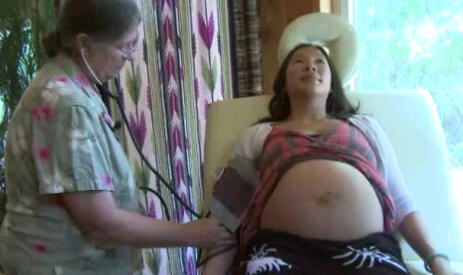Who should have the final say about where a baby is born? In North Carolina, it’s not the parent.
A growing number of educated, health-conscious women are opting to have their babies at home with a midwife, instead of in a hospital with a doctor. A study by the Centers for Disease Control and Prevention found a 29 percent increase in home births from 2004 to 2009, with the biggest increase coming from married, white women who already had children.
Not surprisingly, many doctors disapprove.
Although it is not illegal to give birth at home—some women do it by accident—it has been illegal to do so with the help of a midwife in North Carolina since 1983. As most women aren’t willing to give birth unassisted, home birth is not an option for them.
Despite this, an estimated 600 women have their babies at home in North Carolina each year, while another 300 cross state lines to find midwifery services, according to Russ Fawcett, a board member of North Carolina Friends of Midwives. Yet the ban remains in place.
Data on Home Birth Safety
To obstetricians looking to protect their trade, that’s a good thing. Although there’s no reason to doubt they’re genuinely concerned about women’s safety, obstetricians do actively seek to suppress home births. As one justification, they cite a study published by the American Journal of Obstetrics & Gynecology warning that planned home births have a neonatal death rate “at least twice as high” as that of planned hospital births.
The statistic was repeated often in the summer of 2011 in a legislative committee meeting at which state lawmakers considered licensing midwives.
Midwives say that figure is misleading. A rate “twice as high” represents two out of 1,000 deaths, rather than one out of 1,000 deaths. In addition, most home birth advocates question the validity of the study.
No Significant Mortality Increase
The same study acknowledges there is no significant difference in perinatal mortality (or the death of a fetus), which includes stillbirths.
In fact, midwives argue some hospitals have higher perinatal mortality rates because of babies being delivered forcibly—through labor induction and cesarean sections—before they are ready.
The study also found no difference in the maternal death rate, and that women who planned to give birth at home were less likely to end up with episiotomies, lacerations, or infections.
C-Sections More Dangerous
Home births are much less likely to result in c-sections. Nearly one in three hospital births in North Carolina is by c-section, according to the North Carolina Department of Health and Human Services.
C-sections have been linked to a long list of problems for infants, including premature birth, respiratory and breastfeeding complications, and an increased risk of obesity. For the mother, c-sections are associated with increased blood loss, increased recovery time, and higher chance of death.
These are just the tip of the iceberg when it comes to reasons more women are deciding to have their babies at home.
A Personal Decision
For me, safety was the top concern. Once I had established that my baby and I had about the same chances of survival at home as in a hospital, I considered all the other health risks associated with each place.
A first-time mother and a health fanatic, I did my research and concluded that the safest place for me to welcome my daughter into the world was at the foot of my bed in a pool of warm water, with the help and encouragement of two midwives.
Had I been convinced a hospital was the safest and healthiest place for her to be born, we would have been there. But I wasn’t convinced, and as a parent, I should have the right to follow my convictions about what is best for my child.
Unless someone can prove that giving birth outside of a hospital is abusive or neglectful, the government has no business telling me where I can and cannot give birth to my child, or whom I can hire to assist me.
Respecting Choices in Care
A few weeks ago, one of my midwives was forced to sign a cease and desist order or be arrested for “practicing midwifery” without a license. She was caught after transporting a woman—whose labor was not progressing normally—to a hospital. Three other women have been arrested in North Carolina for “practicing midwifery” within the last two years.
This is outrageous. These are competent, educated, and skilled women who have helped deliver thousands of healthy babies. Hundreds of women in this state love and rely on these women. Without them, we will be forced to cross state lines to deliver our babies in peaceful, nonhospital settings. Some, who don’t have that option, will resort to going it alone.
Instead of throwing midwives in jail—which makes them afraid to transfer women to hospitals when necessary—the state should respect women’s choices of who provides health care and legalize their work.
The ideal time would be before the legislative short session ends in the summer of 2012—but if not that soon, at least before I’m ready to have my second child.





